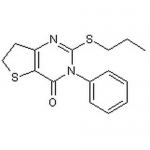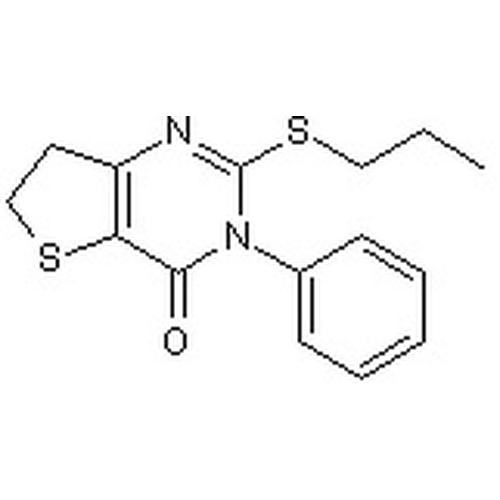| Product Name | BC-11-38 |
| Description |
Inhibitor |
| Purity | >98% (TLC); NMR (Conforms) |
| CAS No. | 686770-80-9 |
| Molecular Formula | C15H16N2OS2 |
| Molecular Weight | 304.43 |
| Field of Use | Not for use in humans. Not for use in diagnostics or therapeutics. For in vitro research use only. |
Properties
| Storage Temperature | -20ºC |
| Shipping Temperature | Shipped Ambient |
| Product Type | Inhibitor |
| Solubility | May be dissolved in DMSO (50 mg/ml); ethanol (14/ mg/ml, warm) |
| Source | Synthetic |
| Appearance | White solid |
| SMILES | CCCSC1=NC2=C(C(=O)N1C3=CC=CC=C3)SCC2 |
| InChI | InChI=1S/C15H16N2OS2/c1-2-9-20-15-16-12-8-10-19-13(12)14(18)17(15)11-6-4-3-5-7-11/h3-7H,2,8-10H2,1H3 |
| InChIKey | YHNDCCKFNWDQGW-UHFFFAOYSA-N |
| Safety Phrases |
Classification: Caution: Substance not yet fully tested. Safety Phrases: S22 - Do not breathe dust S24/25 - Avoid contact with skin and eyes S36/37/39 - Wear suitable protective clothing, gloves and eye/face protection |
| Cite This Product | BC-11-38 (StressMarq Biosciences Inc., Victoria BC CANADA, Catalog # SIH-373) |
Biological Description
| Alternative Names | 6,7-Dihydro-3-phenyl-2-(propylthio)¬thieno[3,2-d]pyrimidin-4(3H)one |
| Research Areas | Neuroscience |
| PubChem ID | 2052828 |
| Scientific Background | BC-11-38 is a small-molecule compound with emerging relevance in cellular signaling research. Although its direct application in neuroscience is still under investigation, BC-11-38 is recognized for its potential to modulate intracellular pathways involved in inflammation and oxidative stress—two central mechanisms in neurodegenerative disease progression. Its pharmacological profile suggests utility in probing signaling cascades that influence glial activation, neuronal survival, and synaptic function. While not yet widely cited in neurodegeneration studies, BC-11-38 holds promise as a candidate for future research into neuroinflammatory modulation and neuroprotective drug development. |



Reviews
There are no reviews yet.